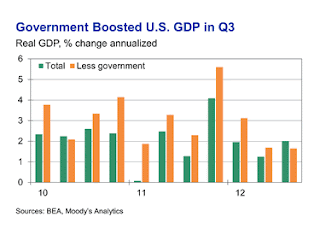More
mixed signals from the manufacturing sector. Prices were up again – indicative
of underlying growing inflationary pressure buildup???
PMI at 51.5%
- New Orders, Employment and Inventories Growing
- Production Contracting
- Supplier Deliveries Slower
(Tempe,
Arizona) — Economic activity in the manufacturing sector expanded in September following three
consecutive months of slight contraction, and the overall economy grew for the 40th consecutive month, say the
nation's supply executives in the latest Manufacturing ISM Report On Business®.
The
report was issued today by Bradley J. Holcomb, CPSM, CPSD, chair of the
Institute for Supply Management™ Manufacturing Business Survey Committee.
"The PMI™ registered 51.5 percent, an increase of 1.9 percentage points
from August's reading of 49.6 percent, indicating a return to expansion
after contracting for three consecutive months. The New Orders Index
registered 52.3 percent, an increase of 5.2 percentage points from August,
indicating growth in new orders after three consecutive months of contraction.
The Production Index registered 49.5 percent, an increase of 2.3 percentage
points and indicating contraction in production for the second time since May
2009. The Employment Index increased by 3.1 percentage points, registering 54.7
percent. The Prices Index increased 4 percentage points from its August
reading to 58 percent. Comments from the panel reflect a mix of optimism
over new orders beginning to pick up, and continued concern over soft global
business conditions and an unsettled political environment."
PERFORMANCE BY
INDUSTRY
Of
the 18 manufacturing industries,11 are reporting growth in September in the
following order: Textile Mills; Food, Beverage & Tobacco Products;
Printing & Related Support Activities; Wood Products; Apparel, Leather
& Allied Products; Paper Products; Petroleum & Coal Products; Primary
Metals; Fabricated Metal Products; Furniture & Related Products; and
Miscellaneous Manufacturing.The six industries reporting contraction in
September — listed in order — are: Nonmetallic Mineral Products; Electrical
Equipment, Appliances & Components; Transportation Equipment; Machinery;
Chemical Products; and Computer & Electronic Products.
WHAT RESPONDENTS ARE
SAYING ...
§ "Appears that our so-called 'slowdown' was a summer thing.
September brings with it increasing requirements and business." (Paper
Products)
§ "Business improved through Q3, but is beginning to show
signs of slowing down in Q4; this has been a typical trend over the last few
years." (Wood Products)
§ "Business has picked up going into the last quarter."
(Plastics & Rubber Products)
§ "We are sticking to our manufacturing plan, but have slowed
production down considerably. Haven't added any new units to the 2012 plan, and
still have no forecast for 2013 released." (Computer & Electronic
Products)
§ "Sales have tanked over the last two months, bringing a
very concerned and stressed management team. Not very optimistic for the
near-term future." (Apparel, Leather & Allied Products)
§ "Uncertainty in the healthcare legislation (reform)
continues to be the underlying force keeping our sales revenue below its full
potential." (Miscellaneous Manufacturing)
§ "Steel and aluminum prices still dropping, and auto
production orders are up." (Transportation Equipment)
§ "Domestic business is up; international is down."
(Electrical Equipment, Appliances & Components)
§ "Demand seems to have stabilized from August. New orders
are appearing this month without advanced notice from our customers."
(Chemical Products)
|
MANUFACTURING AT A GLANCE
SEPTEMBER 2012
|
|
Index
|
Series
Index
Sep
|
Series
Index
Aug
|
Percentage
Point
Change
|
Direction
|
Rate
of
Change
|
Trend*
(Months)
|
|
PMI™
|
51.5
|
49.6
|
+1.9
|
Growing
|
From
Contracting
|
1
|
|
New
Orders
|
52.3
|
47.1
|
+5.2
|
Growing
|
From
Contracting
|
1
|
|
Production
|
49.5
|
47.2
|
+2.3
|
Contracting
|
Slower
|
2
|
|
Employment
|
54.7
|
51.6
|
+3.1
|
Growing
|
Faster
|
36
|
|
Supplier
Deliveries
|
50.3
|
49.3
|
+1.0
|
Slowing
|
From
Faster
|
1
|
|
Inventories
|
50.5
|
53.0
|
-2.5
|
Growing
|
Slower
|
2
|
|
Customers'
Inventories
|
49.5
|
49.0
|
+0.5
|
Too
Low
|
Slower
|
10
|
|
Prices
|
58.0
|
54.0
|
+4.0
|
Increasing
|
Faster
|
2
|
|
Backlog
of Orders
|
44.0
|
42.5
|
+1.5
|
Contracting
|
Slower
|
6
|
|
Exports
|
48.5
|
47.0
|
+1.5
|
Contracting
|
Slower
|
4
|
|
Imports
|
49.5
|
49.0
|
+0.5
|
Contracting
|
Slower
|
2
|
|
|
|
|
|
|
|
|
OVERALL ECONOMY
|
Growing
|
Faster
|
40
|
|
Manufacturing Sector
|
Growing
|
From
Contracting
|
1
|
COMMODITIES REPORTED UP/DOWN IN PRICE and IN SHORT SUPPLY
Commodities Up in Price
Caustic Soda (2); Corn
(3); Corn Products (2); Corrugated Boxes (2); Flour; Fuel (2); Gasoline; HDPE;
Soy Bean Oil; Steel*; and Structural Steel.
Commodities Down in Price
Aluminum (2); Nickel
(2); Stainless Steel (3); Steel* (7); and Steel Products.
Commodities in Short Supply
Plastic Components is
the only commodity reported in short supply.




